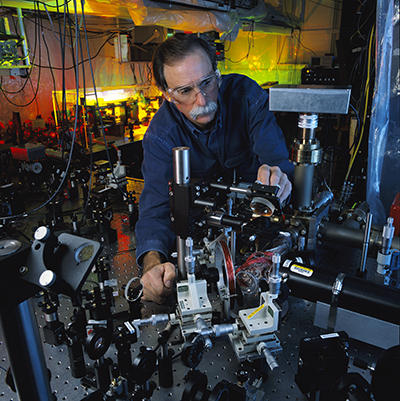
NIST physicist David Wineland adjusts an ultraviolet laser beam used to manipulate ions in a high-vacuum apparatus containing an "ion trap." These devices have been used to demonstrate the basic operations required for a quantum computer. Such computers, by relying on quantum mechanics rather than transistors to perform calculations or store information, could someday solve problems in seconds that would take months on today's best supercomputers.
David J. Wineland, a physicist at the U.S. Department of Commerce's National Institute of Standards and Technology (NIST), has won the 2012 Nobel Prize in Physics. The honor is NIST's fourth Nobel prize in physics in the past 15 years.
Wineland shared the prize with Serge Haroche of the Collège de France and Ecole Normale Supérieure in Paris, France. In announcing the winners today, the Royal Swedish Academy of Sciences cited Wineland and Haroche "for ground-breaking experimental methods that enable measuring and manipulation of individual quantum systems."
Wineland got the call at about 3:30 a.m. today at his home in Boulder, Colo. "I was a little sleepy. My wife got the call. I haven't actually asked her yet what they said, but she gave the phone to me," Wineland recalled shortly afterwards. "It's kind of overwhelming. This could have gone to a lot of other people. It's certainly a wonderful surprise. The fellow I shared it with – he and I have been friends for a long time, so it's nice to share it with him."
The Nobel citation notes that Wineland and Haroche's methods have enabled science to take "the very first steps towards building a new type of super fast computer based on quantum physics. Perhaps the quantum computer will change our everyday lives in this century in the same radical way as the classical computer did in the last century. The research has also led to the construction of extremely precise clocks that could become the future basis for a new standard of time, with more than hundred-fold greater precision than present-day cesium clocks."
"We're so excited for Dave, along with his many colleagues and friends around the world, for this recognition of decades of world-leading research," said Under Secretary of Commerce for Standards and Technology and NIST Director Patrick Gallagher. "Dave's work embodies NIST's mission to pioneer new measurement science that will substantially advance technology and innovation."
Wineland has worked at NIST for 37 years and is internationally recognized for his research on trapped ions, which are electrically charged atoms. He conducted landmark experiments on laser cooling, which involves the use of lasers to cool ions to near absolute zero. This led to the development of laser-cooled atomic clocks, the current state-of-the-art clock in time and frequency standards; advances in experimental quantum computing, which use the rules of quantum physics to potentially solve important problems, such as breaking the best data encryption codes, which are intractable using today's technology; and ultraprecise next-generation atomic clocks based on single ions.
Wineland achieved the first demonstration of laser cooling in 1978 and has built on that breakthrough with many experiments that represent the first or best in the world - often both - in using trapped laser-cooled ions to test theories in quantum physics and demonstrate crucial applications. Wineland was the first to successfully demonstrate the building blocks of a practical quantum computer (using the so-called DiVincenzo criteria).
Wineland's pioneering accomplishments include:
- The first single atom quantum logic gate (1995), demonstrating the feasibility of processing information using quantum properties of ions.
- The first demonstration of deterministic entanglement with two ions (1998) proving that information is distributed simultaneously between the two ions, a prerequisite for quantum computation.
- The first demonstration of entanglement of four ions (2000) proving in principle that quantum computation with ions can be scaled to the relatively large number of quantum gates needed for a practical quantum computer.
- The first demonstration of quantum teleportation of information among massive particles (2004, simultaneously with the Innsbruck group), providing a potentially crucial method for efficient transfer of information within a large-scale quantum computer.
- The first demonstration of a "quantum logic atomic clock" (2005). This clock is now the world's most precise atomic clock and would neither gain nor lose one second in about 4 billion years.
Wineland was born in Wauwatosa, Wis., near Milwaukee. His family then settled briefly in Denver and when he was three moved to Sacramento, Calif., where he grew up. Wineland has worked at NIST laboratories in Boulder, Colo., since 1975. He received a bachelor of arts in physics from the University of California at Berkeley and master's and doctoral degrees in physics from Harvard University. Before joining NIST, Wineland worked as a postdoctoral research associate at the University of Washington.
Wineland is a member of the National Academy of Sciences and has won a host of other awards, including the 2007 National Medal of Science, the 2010 Benjamin Franklin Medal in Physics, the Society of Optical and Quantum Electronics' Einstein Medal for Laser Science, the American Physical Society's Arthur L. Schawlow Prize in Laser Science, the International Award on Quantum Communications, the Optical Society of America's Frederick Ives Award, and the Presidential Rank Award for Distinguished Senior Executives and Professionals.
Wineland also has helped train new generations of scientists working throughout the world and has published more than 250 refereed articles, many in the most prestigious research journals.
The Nobel citation can be found at: http://www.nobelprize.org/nobel_prizes/physics/laureates/2012/press.html
Selected NIST press releases on Wineland's research:

